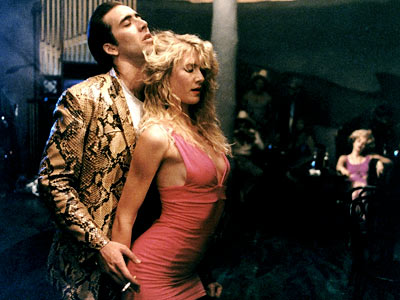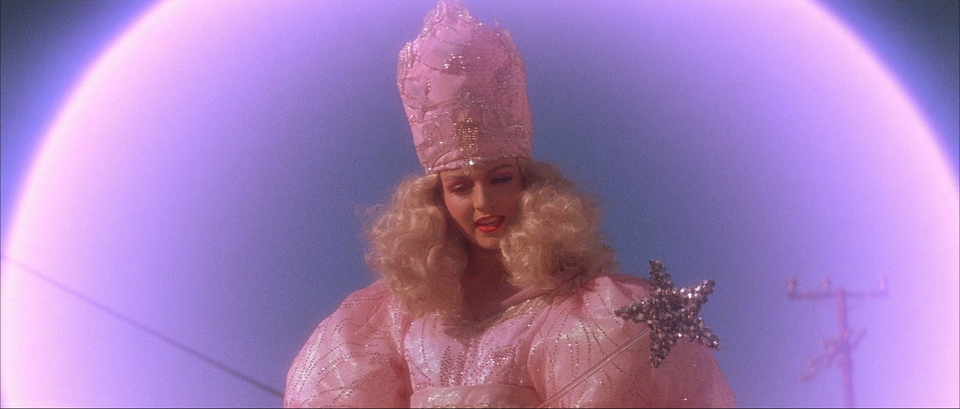
Splatter Cinema and Enjoy the Film present AMERICAN PSYCHO (2000); Dir. Mary Harron; Starring Christian Bale, Justin Theroux, Chloë Sevigny, Willem Dafoe and Jared Leto; Wednesday, May 13 @ 8:30 p.m.; Cinevision Screening Room; Tickets $10 (cash only); Trailer here.
By Aleck Bennett
Contributing Writer
Splatter Cinema has returned—this time backed by a successful Kickstarter campaign to pre-fund this month’s screening. Once again teaming up with ATLRetro Kool Kat Ben Ruder’s Enjoy the Film and the Cinevision Screening Room, Splatter continues into its seventh year of savagery with its mission still intact—to deliver the buckets of blood and delightful scenes of slaughter that make life worth living. This time around, Christian Bale drenches the screen with gore in Mary Harron’s turn-of-the-millennium classic AMERICAN PSYCHO!
Sometimes the most annoying question a movie geek like me can face when talking about an adaptation of a novel is this: “How does it compare to the book?” My gut reaction is that it’s a pointless exercise to compare the two. One speaks in a written language, one visual. They use completely different modes of expression. The only thing the two media really have in common is that they tend to be storytelling ventures. But beyond that, it’s like comparing rhubarb to a Jackson Pollock painting. You can do it, and even say that one is better than the other, but it’s kind of a fool’s errand.
 However, since I’m feeling foolish, let me just say for the record that the film AMERICAN PSYCHO is far better than the novel. How can I say that? Easy. I can’t stand the novel, yet I love the movie. I dunno. Maybe I don’t like rhubarb.
However, since I’m feeling foolish, let me just say for the record that the film AMERICAN PSYCHO is far better than the novel. How can I say that? Easy. I can’t stand the novel, yet I love the movie. I dunno. Maybe I don’t like rhubarb.
Requisite plot summary: Patrick Bateman is a young Wall Street banker in the late 1980s that kills people in his spare time. The casual ruthlessness needed for success in his job extends to his personal life, in which he sees people as nothing more than walking slabs of meat, their lives holding no more importance than their business cards.
Bret Easton Ellis’ 1991 novel was something of a cause célèbre at the time of its publication, having been rejected by Simon & Schuster before being picked up for a trade paperback release by Vintage Books. Widespread outrage over the book’s content (specifically its gratuitous depictions of violence against women) generated acres of press coverage, vehement debate and calls for the novel to be pulled from distribution. Being curious about all the hubbub and brouhaha, I picked it up. And the chief impression that the book left was just how banal and glib it all was – shallow depictions of a shallow life punctuated by shallow descriptions of nauseatingly graphic violence. It seemed completely cut adrift from itself, accidentally being a prime example of what it ostensibly criticizes. Unlike, say, Chuck Palahniuk, Ellis never reveals anything beneath the surface of his cipher-esque characters. Whereas the nameless, catalog-shopping narrator of FIGHT CLUB becomes increasingly complex and interesting over the course of the story’s development; Patrick Bateman just simply is what he is. And for a character with more depth, that may be all you need. But for a character that doesn’t extend beyond the mask of humanity he wears, it’s not enough. And in a work in which nobody else lives beyond the surface, which doesn’t even seem to believe that anything beyond the surface even exists, it simply comes off as a lazy portrait (or even an embrace) of a lifestyle rather than a pointed critique of that lifestyle.
On top of that, its jokes fall flat and its vaunted scenes of violence seem shoehorned in for nothing more than attention-grabbing shock value. (In fact, Ellis held off on writing any of the violent passages until he finished the book, going back to research serial killers and write depictions of murder and  mayhem to insert into the narrative at a later date. And it feels like it.) And the novel never seems to know precisely what its target is. Is it about how desensitized we’ve become to violence? Is it about Patrick Bateman as the perfect distillation of capitalism, making mincemeat of others in order to advance in the world, as a kind of slasher film equivalent of WALL STREET’s (1987) Gordon Gekko? Is it about the glib surface-living culture of the 1980s? Is it simply a reflection of the life and mindset that Ellis admits to living at the time of the novel’s writing? Ellis never seems sure, and couches his indecision (which ends up feeling like he just doesn’t care what it’s about) in quasi-literary pretension and stylistic fakery.
mayhem to insert into the narrative at a later date. And it feels like it.) And the novel never seems to know precisely what its target is. Is it about how desensitized we’ve become to violence? Is it about Patrick Bateman as the perfect distillation of capitalism, making mincemeat of others in order to advance in the world, as a kind of slasher film equivalent of WALL STREET’s (1987) Gordon Gekko? Is it about the glib surface-living culture of the 1980s? Is it simply a reflection of the life and mindset that Ellis admits to living at the time of the novel’s writing? Ellis never seems sure, and couches his indecision (which ends up feeling like he just doesn’t care what it’s about) in quasi-literary pretension and stylistic fakery.
I really hate this book, in case you haven’t caught on.
So when I heard back in the day that it was going to be made into a movie, I was less than excited. I mean, Hollywood had managed to turn Ellis’ similarly shallow morality tale, LESS THAN ZERO (1987) into a movie with even less depth than the novel. But then the news came down that the adaptation was both written and directed by women—not just women, but, gloriously, feminists!—something that I (correctly) hoped would bring a certain sense of smart irony to the film, given the absolutely rampant misogyny of the novel. To make matters even better, their screenplay was chosen over one written by Bret Easton Ellis himself. The check marks in the “plus” column were soon vastly outnumbering those under the “minus” heading.
And the movie succeeds on almost every level in which the novel fails. The screenplay by director Mary Harron and GO FISH (1994) screenwriter Guinevere Turner brings the latent humor lurking in Ellis’ novel to life, while amping up the sense of sickening horror surrounding Bateman’s crimes, which are so blandly and matter-of-factly depicted in the original source. Rather than embracing the attitudes of the novel, the film slyly and wittily  transforms the book’s depictions of women into a comment on male vanity and competitiveness. Meanwhile, Christian Bale’s performance also manages to transcend the source material, giving us a Bateman with an intensity and (at times) frenzied energy that belies his character’s detachment and superficiality. And the end result is a film that is focused. All of the things that felt like directionless elements in the novel—the misogyny, the over-the-top ultraviolence, the preening narcissism, the steady divorcing of the protagonist from “reality”—now have an aim and a purpose: to show Bateman as the perfect embodiment of an American dream gone sour. Climbing atop and feeding upon the corpses of those beneath him, devaluing anyone that stands in his way, and growing further and further out of touch with the rest of the world and yet he succeeds. Not in spite of his particular brand of American psychosis, but because of it. This is what is expected of you, the film seems to say, and then openly mocks the society that calls for it. Maybe it’s because Mary Harron is a Canadian and can view America from a skeptical distance while still being close enough to grasp the details—the same quality that I think helps to make Jen & Sylvia Soska’s similarly themed and titled film AMERICAN MARY (2013) work so well. Or maybe it’s that the intervening decade has allowed Harron to take on the 1980s Yuppie culture with a more knowing eye than the still-too-close 1991 novel. But no matter the reason, Mary Harron’s film captures a particular type of mindset from a particular age perfectly and then skewers it with wit and perfect technique, leaving us to identify its lingering traces today.
transforms the book’s depictions of women into a comment on male vanity and competitiveness. Meanwhile, Christian Bale’s performance also manages to transcend the source material, giving us a Bateman with an intensity and (at times) frenzied energy that belies his character’s detachment and superficiality. And the end result is a film that is focused. All of the things that felt like directionless elements in the novel—the misogyny, the over-the-top ultraviolence, the preening narcissism, the steady divorcing of the protagonist from “reality”—now have an aim and a purpose: to show Bateman as the perfect embodiment of an American dream gone sour. Climbing atop and feeding upon the corpses of those beneath him, devaluing anyone that stands in his way, and growing further and further out of touch with the rest of the world and yet he succeeds. Not in spite of his particular brand of American psychosis, but because of it. This is what is expected of you, the film seems to say, and then openly mocks the society that calls for it. Maybe it’s because Mary Harron is a Canadian and can view America from a skeptical distance while still being close enough to grasp the details—the same quality that I think helps to make Jen & Sylvia Soska’s similarly themed and titled film AMERICAN MARY (2013) work so well. Or maybe it’s that the intervening decade has allowed Harron to take on the 1980s Yuppie culture with a more knowing eye than the still-too-close 1991 novel. But no matter the reason, Mary Harron’s film captures a particular type of mindset from a particular age perfectly and then skewers it with wit and perfect technique, leaving us to identify its lingering traces today.
So no matter how you may have felt about the novel, there’s no need to fear that this adaptation doesn’t do it justice. If you loved Ellis’ book, you’ll find a movie that easily snares the essence of what you find rewarding in it. If you loathed the novel, then you’ll find a movie that does exactly what Ellis was  likely trying to do, and does it miles better. And you can’t ask for a better team of people to bring this film to you—Splatter Cinema always makes their screenings fun, and Ben Ruder knows how movies ought to look on the big screen. So get there early, get your picture taken with Patrick Bateman and maybe enjoy some Huey Lewis & the News while you’re waiting. It may not be hip to be square, but if you’re not there, that’s what you’ll be.
likely trying to do, and does it miles better. And you can’t ask for a better team of people to bring this film to you—Splatter Cinema always makes their screenings fun, and Ben Ruder knows how movies ought to look on the big screen. So get there early, get your picture taken with Patrick Bateman and maybe enjoy some Huey Lewis & the News while you’re waiting. It may not be hip to be square, but if you’re not there, that’s what you’ll be.
Aleck Bennett is a writer, blogger, pug warden, pop culture enthusiast, raconteur and bon vivant from the greater Atlanta area. Visit his blog at doctorsardonicus.wordpress.com.




